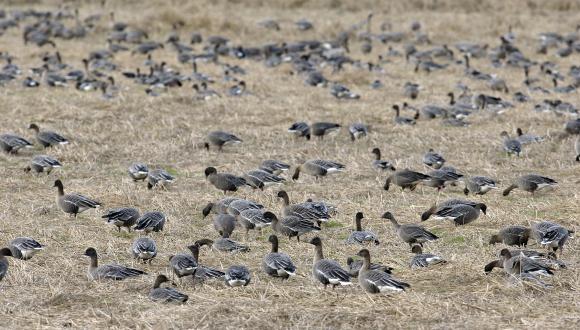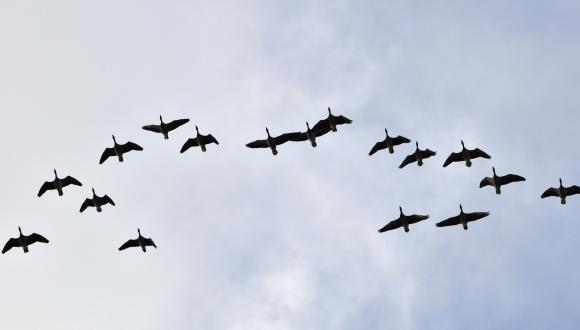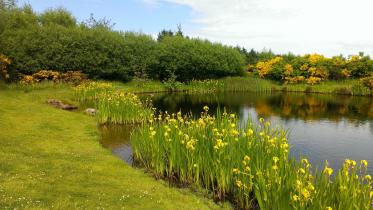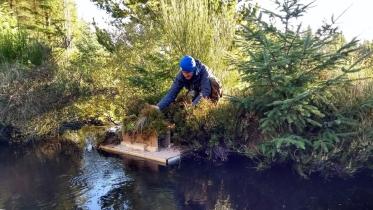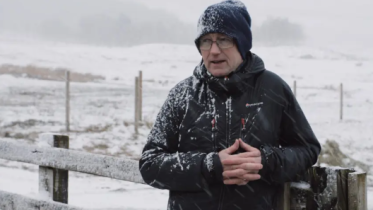Islay Goose Management Scheme
This aims to maintain sustainable populations of wintering geese on Islay while minimising the agricultural damage and economic losses they cause.
Scheme overview
Location: Isle of Islay
Goose species: Greenland barnacle goose, Greenland white-fronted goose
Population level: average count in 2020/21 – 33,413 Greenland barnacle geese, 6,121 Greenland white-fronted geese
Extent: more than 6,000 hectares of agricultural land
Number of participants: 80 land managers approx.
Duration: 4 years, from October 2017 to May 2021. Extension has been agreed to March 2023.
The Islay Goose Management Scheme delivers management agreed through the Islay Sustainable Goose Management Strategy.
Eligibility
To be eligible, agricultural land must:
- lie within an area of high goose use
- support an eligible crop in a suitable condition to attract geese
- have an undisturbed goose feeding zone that occupies at least 60% of the holding
View a map of eligible fields below.
View the Islay Local Goose Management Scheme eligibility table
How to apply
You must identify on a map the locations of any areas to be managed under this option each year.
You must keep records of:
- reseed frequency for pasture on your holding
- stock turnout dates
- sowing dates for spring barley
- cutting dates for silage
You should submit this information with your application to join the scheme.
Download the Islay Local Goose Management Scheme application form.
Management requirements from 1 October to 30 April (inclusive)
Provision of undisturbed feeding refuge
- Provide undisturbed ground for goose feeding on at least 60% of each holding entered into the scheme.
- Maintain productive grassland crops for the feeding zone.
Scaring
- Scaring can take place on up to 40% of the holding area.
- Lethal scaring of barnacle geese is permitted, under licence, from first- and second-year reseeds within the feeding zone and from any optional buffer area.
- Non-lethal scaring is permitted from first- and second-year reseeds and from the buffer area.
- NatureScot contract marksmen will regularly visit all licensed areas (from November to March).
- You must let NatureScot contract marksmen undertake lethal scaring of barnacle geese, where fields meet the criteria.
- Land managers undertaking non-lethal scaring are responsible for buying and erecting any scaring equipment.
Payment
View the Islay Local Goose Management Scheme Payment rates
- Payments are based on the density of geese that the land supports during the scheme period (birds per hectare from October to April).
- Rotational ground (reseeded in the last 7 years) attracts a higher payment rate than permanent pasture as it’s more productive and requires more frequent reseeding to mitigate goose damage.
- Buffer areas attract a lower payment rate than the equivalent crop within the feeding zone as scaring can take place over this land (the calculation assumes scaring will reduce goose usage by 22%).
- Minimum payment area: land managers must carry out a small amount of goose scaring and allow monitoring staff onto their land.
Monitoring
Goose numbers and distribution
- Goose counts are carried out roughly fortnightly from November to March. A total of 15 counts are completed per holding per season.
- Population counts (international) are completed four times per season: in November, December, January and March.
- We use the 7-year rolling farm average to calculate payments.
Proportion of the goose population supported by the scheme
In 2020/21 we estimate 89% of the geese counted on Islay were supported by the Scheme.
Damage monitoring
To measure the damage geese cause to agriculture within the Scheme area, and to detect whether their impacts are increasing/decreasing, NatureScot measures sward heights and the extent of grass cover from sample fields. These measurements are undertaken as directed by the Islay Sustainable Goose Management Strategy.
Farmer perception monitoring
NatureScot plans to issue a questionnaire towards the end of the current scheme. This will ask land managers about their perceptions of the scheme, their level of satisfaction with it, and levels of damage caused by geese.
Cropping practices
We monitor cropping practices to assess long-term trends in goose damage levels and the effects of damage on farming practices. A questionnaire is sent out annually prior to the start of the goose season to gather data on: reseed frequency, stock turnout dates, spring barley sowing dates and cutting dates for silage.
Inspections
The following checks ensure compliance with the scheme’s eligibility criteria and management requirements.
Before land joins the scheme, NatureScot will check its goose count data for the last 7 years and the current year’s Integrated Administration and Control System (IACS) data. The land will be visited before 31 December to ensure it meets the eligibility criteria.
Field size and boundary data will be checked against current IACS data before payments are made. Field size is checked, and payments are made, against the net field area supplied by SGRPID.
While the scheme is operating, scaring activity must not be undertaken within any feeding zone fields other than the first- or second-year reseeds. Inspectors will note where and when scaring devices are in use.
If you carry out lethal scaring of barnacle geese, we will check that you (or the contract marksmen) hold a licence to do so on your land.
You must not shoot or permit shooting in fields where Greenland white-fronted geese are present and within the same flock as barnacle geese.
Holdings within Gruinart Flats Special Protection Area (SPA) have a low bag limit during October and November: you can take only one shot per flock on any single occasion and you must use a rifle.
Any first- and second-year reseeds must establish well. Fields will be inspected in the autumn for signs that the field has been ploughed and the crop has established. Where land is surface-seeded, you must also maintain records of fertiliser and seed purchases for inspection.
